Are you looking to improve your health and fitness? Monitoring your body fat percentage can be a valuable tool in achieving your objectives.
In this article, we’ll explore the chart for body fat percentage and how to use it to understand body composition better.
When you learn how to measure and interpret your body fat percentage, you can make smart decisions about your diet and exercise routine to improve your overall health.
Additionally, we’ll discuss factors that influence body fat percentage and provide tips on improving it.
Read on to discover how to use the chart for body fat percentage to achieve your health and fitness goals.
Measure Your Body Fat: Body Fat Percentage Calculator Based On Caliper and US Navy

- What Is Body Fat Percentage
- 1. ACE Body Fat Percentage Chart
- ACE Percent Body Fat Norms For Men And Women
- 2. Men Body Fat Percentage Chart As Per Age
- 3. Women Body Fat Percentage Chart As Per Age
- 4. Army Body Fat Chart (Standards)
- Maximum Allowable Body Fat Percentage to Join*
- Maximum Body Fat Percentage Standard after Entry*
- 5. USMC Body Fat Chart (Standards)
- 6. Jackson & Pollard Ideal Body Fat Percentages Chart
- Healthy and Unhealthy Body Fat Percentage
- How To Measure Body Fat Percentage
- 1. BMI Calculator
- 2. US Navy Tape Measure Method
- 3. Skinfold Calipers Method
- 4. Bioelectrical Impedance
- 5. Underwater Weighing or Hydrodensitometry
- 6. DXA or Dual-Energy X-ray Absorptiometry
- 7. Air Displacement Plethysmography
- How To Use Body Fat Percentage Chart
- 1. Assessing Overall Health
- 2. Tracking Weight Loss Progress
- 3. Evaluating Fitness Level
- 4. Personalizing Nutrition And Exercise Plans
- 5. Setting Realistic Goals
- How To Reduce Body Fat
- FAQs
- How can I measure my body fat at home?
- What should women’s body fat percentage be?
- How accurate is a body fat chart?
- What are the risks of having too much or too little body fat?
- Takeaways
- Reference
What Is Body Fat Percentage
Body fat, also known as ‘adipose tissue,’ serves multiple functions, including energy storage, hormone secretion, and cushioning, and insulation.
Body fat percentage measures the amount of fat in the body relative to total body weight. It represents the proportion of fat mass to lean body mass.
Body fat percentage is a better indicator of overall health and fitness than simply measuring body weight or body mass index (BMI) alone.
A healthy body fat percentage can vary depending on age, gender, and activity level. Generally, men have a lower body fat percentage than women.
According to the American College of Sports Medicine, the recommended body fat percentage ranges are as follows:
It’s important to note that too little or too much body fat can be bad for your health.
- Having too little body fat can lead to hormonal imbalances and an increased risk of osteoporosis,
- Having too much body fat can increase the risk of heart disease, diabetes, and other health problems.
Therefore, it is important to maintain a healthy body fat percentage for health and well-being.
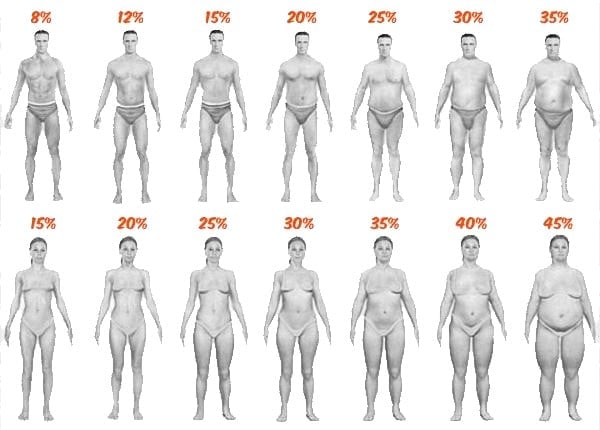
1. ACE Body Fat Percentage Chart
The American Council on Exercise, Body Fat categorization is one of the most commonly used body fat charts.(1)
As illustrated by the below chart, women have a higher body fat percentage than men at a given level. This is due to differences in physiological functions, including hormones, breasts, and sexual organs. Furthermore, women require a higher amount of body fat for ovulation.
The ACE chart has one limitation: it does not consider age differences, so I included the next chart.
The chart below is a good starting point for everyone with different shapes, sizes, and fat distribution profiles.
ACE Percent Body Fat Norms For Men And Women
| Classification | Women | Men |
|---|---|---|
| Essential Fat | 10-13% | 2-5% |
| Athletes | 14-20% | 6-13% |
| Fitness | 21-24% | 14-17% |
| Acceptable | 25-31% | 18-24% |
| Obese | >32% | >25% |
2. Men Body Fat Percentage Chart As Per Age
This body fat percentage chart for men is comprehensive depending on the age group. (2)
| Age Group | Low (Increased Health Risk) | Excellent/Fit (Healthy) | Good/Normal (Healthy) | Fair/Average (Healthy) | Poor (Increased Health Risk) | High (Increased Health Risk) |
|---|---|---|---|---|---|---|
| 20-29 | <8 | </=10.5 | 10.6-14.8 | 14.9-18.6 | 18.7-23.1 | >/=23.2 |
| 30-39 | <8 | </=14.5 | 14.6-18.2 | 18.3-21.3 | 21.4-24.9 | >/=25 |
| 40-49 | <8 | </=17.4 | 17.5-20.6 | 20.7-23.4 | 23.5-26.6 | >/=26.7 |
| 50-59 | <8 | </=19.1 | 19.2-22.1 | 22.2-24.6 | 24.7-27.8 | >/=27.9 |
| 60-69 | <8 | </=19.7 | 19.8-22.6 | 22.7-25.2 | 25.3-28.4 | >/=28.5 |
3. Women Body Fat Percentage Chart As Per Age
These body fat percentage charts for women are comprehensive depending on age group.
| Age Group | Low (Increased Health Risk) | Excellent/Fit (Healthy) | Good/Normal (Healthy) | Fair/Average (Healthy) | Poor (Increased Health Risk) | High (Increased Health Risk) |
|---|---|---|---|---|---|---|
| 20-29 | <14 | </=16.5 | 16.6-19.4 | 19.5-22.7 | 22.8-27.1 | >27.2 |
| 30-39 | <14 | </=17.4 | 17.5-20.8 | 20.9-24.6 | 24.7-29.1 | >29.2 |
| 40-49 | <14 | </=19.8 | 19.9-23.8 | 23.9-27.6 | 27.7-31.9 | >31.3 |
| 50-59 | <14 | </=22.5 | 22.6-27 | 27.1-30.4 | 30.5-34.6 | >34.6 |
| 60-69 | <14 | </=23.2 | 23.3-27.9 | 28-31.3 | 31.4-35.4 | >35.5 |
You may have noticed as your age increases, your acceptable body fat within these ranges increases as well
4. Army Body Fat Chart (Standards)
A good body fat percentage is a key medical fitness requirement for people who want to join and stay in the U.S. Army.
The Department of Defense regularly updates its body fat requirements as part of the Standards of Medical Fitness, with the most recent publication on June 27, 2019. The current body fat requirements are outlined in two tables.
Measure Your Body Fat: Body Fat Percentage Calculator Based On US Army
Maximum Allowable Body Fat Percentage to Join*
| Age | Male | Female |
|---|---|---|
| 17-20 | 24% | 30% |
| 21-27 | 26% | 32% |
| 28-39 | 28% | 34% |
| 40 and over | 30% | 36% |
Maximum Body Fat Percentage Standard after Entry*
| Age | Male | Female |
|---|---|---|
| 17-20 | 20% | 30% |
| 21-27 | 22% | 32% |
| 28-39 | 24% | 34% |
| 40 and over | 26% | 36% |
Nonetheless, the DOD encourages all personnel to strive for more rigorous body fat goals, which are
- 18% for males
- 26% for females
5. USMC Body Fat Chart (Standards)
The United States Marine Corps (USMC) uses a specific body fat chart to assess the body composition of its personnel.
The chart is based on age and gender and has specific body fat percentage requirements for different categories of Marines, such as officers and enlisted personnel.
The maximum allowable body fat percentages for:
- Male Marines:18% to 21%,
- Female Marines: 27% to 30%.
Failure to meet the requirements may result in adverse actions, such as being placed on a body fat program or facing disciplinary action.
| Age Group | Male Body Fat Standards | Female Body Fat Standards |
|---|---|---|
| 17-20 | 18% | 27% |
| 21-25 | 18% | 27% |
| 26-30 | 19% | 28% |
| 31-35 | 19% | 28% |
| 36-40 | 20% | 29% |
| 41-45 | 20% | 29% |
| 46-50 | 21% | 30% |
| 51+ | 21% | 30% |
Please note: These standards are specific to the USMC and may not apply to other branches of the military or other organizations.
6. Jackson & Pollard Ideal Body Fat Percentages Chart
| Age | Women | Men |
|---|---|---|
| 20 | 17.7% | 8.5% |
| 25 | 18.4% | 10.5% |
| 30 | 19.3% | 12.7% |
| 35 | 21.5% | 13.7% |
| 40 | 22.2% | 15.3% |
| 45 | 22.9% | 16.4% |
| 50 | 25.2% | 18.9% |
| 55 | 26.3% | 20.9% |
Healthy and Unhealthy Body Fat Percentage
Body fat is an important measure of health, but stating that a certain level of body fat is “unhealthy” doesn’t tell the whole story.
Body fat comprises two types:
- Essential body fat
- Storage body fat.
Essential body fat is a foundational level of fat distributed throughout the body, which is necessary for maintaining vital life and reproductive functions.
There is a lot of controversy over what amount of body fat is optimal for overall health.
- Men typically have around 2-5% essential body fat, while women have around 10-13%.
- The healthy range for body fat in men is 10-22%, and for women it is 20-32%.
A percentage above or below this range is typically considered unhealthy and may put a person at risk for health problems.
The percentage of body fat can also vary between different population groups, and factors like age, sex, and activity level can affect it.
For example, endurance runners tend to have less body fat than swimmers, and people living near the North or South Pole generally have more body fat than those living in moderate temperature zones.
How To Measure Body Fat Percentage
Estimating body fat percentage is not routinely done as it has advantages, disadvantages, and margins of error.
However, there are several common methods available for this purpose, including:
- BMI
- US Navy Tape Measure Method
- Skinfold Calipers Method
- Bioelectrical Impedance Method
- Hydrostatic Weighing Method
- Air displacement plethysmography (ADP)
- DEXA Scan Method
1. BMI Calculator
BMI stands for Body Mass Index, and it is a measure of body fat based on a person’s weight and height.
According to the American Heart Association, BMI is a numerical indicator of the relationship between your weight and height. It is calculated by dividing your weight in kilograms by the square of your height in meters.
Many doctors use the resulting number to categorize a person’s body weight as underweight, normal, overweight, or obese.
BMI Chart For Both Male And Females
The resulting number is then compared to BMI categories that have been established by the World Health Organization (WHO) and other health organizations. These categories include:
- Underweight: less than 18.5
- Normal weight: 18.5 to 24.9
- Overweight: 25 to 29.9
- Obese: 30 to 35
- Morbid obesity: Over 35
Obesity is frequently subdivided into categories:
- Obesity Class 1: BMI of 30 to < 35
- Obesity Class 2: BMI of 35 to < 40
- Obesity Class 3: BMI of 40 or higher. Class 3 obesity is sometimes categorized as “severe” obesity.
Body fat percentages, on the other hand, also have issues and limitations. BMI can be confusing when it comes to distinguishing between muscle and fat mass, particularly for fit individuals.
For instance, an athletic person with extra lean mass may have a higher BMI and be categorized as overweight or obese.
To Measure Your Body Mass Index (BMI) Click Here
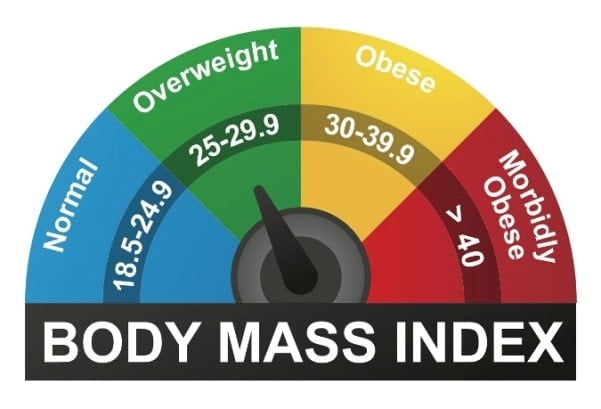
2. US Navy Tape Measure Method
The Navy Tape Measure Method, or the US Navy Circumference Method, is a simple technique used to estimate a person’s body fat percentage based on body measurements.
You can use the Navy tape measure method to estimate your body fat percentage by looking at your height, neck, and waist circumference.
It is simple, fast, and reliable, since you don’t need to use calipers.
Although this method is fairly accurate, it also tends to overestimate the body fat percentage of fairly lean people (men under 15% body fat and women under 25%).
It is, therefore, best used for people with more body fat than this.
Navy Tape Body Fat Percentage Formula For Males
- Body Fat Percentage (%) = 495 / (1.0324 – 0.19077 x log10(waist – neck) + 0.15456 x log10(height)) – 450
Measurement Locations For Males
- Height (cm)
- Neck (cm)
- Abdomen (cm)
Navy Tape Body Fat Percentage Formula For Female
- Body Fat Percentage (%)= 495 / (1.29579 – 0.35004 x log10(waist + hip – neck) + 0.22100 x log10(height)) – 450
Measurement Locations For Females
- Height (cm)
- Neck (cm)
- Waist (cm)
- Hips (cm)
The tape test requires multiple measurements, which can lead to errors. To ensure accuracy, measurements must be taken at least three times.
Additionally, factors such as clothing, the tension of the tape, and recent food consumption can influence the results. It’s crucial to have a proficient person conduct the measurements to guarantee precision.
3. Skinfold Calipers Method
This method involves measuring the thickness of fat at three or more sites on the body using a caliper. It reasonably estimates body fat composition, especially when measurements are taken from several sites.
However, the results can vary depending on the person taking the measurements or the lack of training in the person performing the measurements.
There are many ways to calculate body fat using skinfold measurements, which measure subcutaneous fat thickness at specific places on the body.
The most commonly used methods for calculating skinfold body fat include:
- Jackson-Pollock 3 Site Caliper Method
- Jackson-Pollock 4 Site Caliper Method
- Jackson-Pollock 7 Site Caliper Method
- Parrillo Caliper Method
- Durnin And Womersley Caliper Method
Similar to the tape test, the skinfold test has a considerable margin for error, especially if the user is unfamiliar with calipers. Henry C. Lukaski, the author of Body Composition, suggests that the skinfold test may have an error range of 3.5-5% body fat.
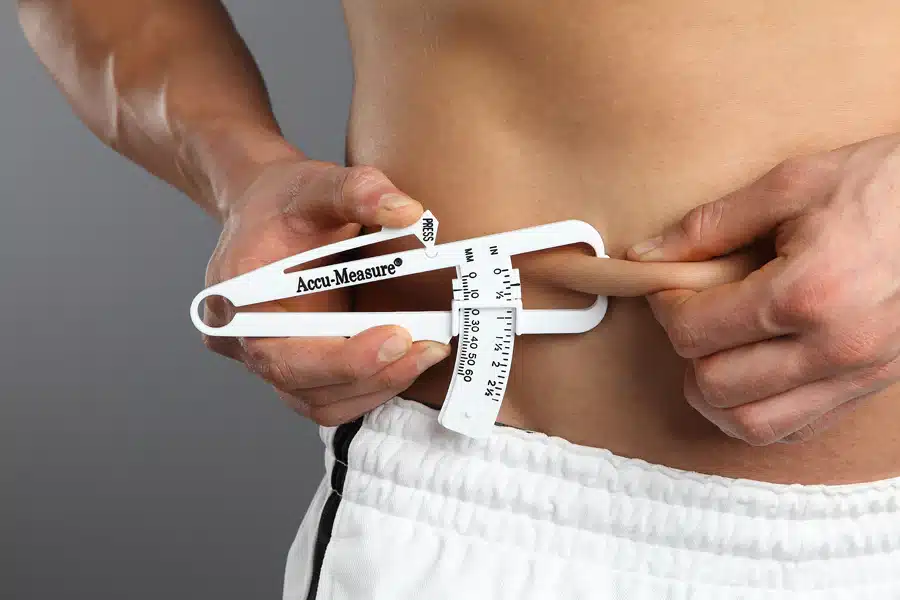
4. Bioelectrical Impedance
The bioelectrical impedance analysis method employs electrodes under each foot or additional electrodes in handholds to measure body fat percentage.
The method involves transmitting tiny electrical impulses through the body and detecting how quickly they return, with quicker responses associated with a slimmer body. It offers advantages such as being quick, easy, and affordable.
However, the method is substantially less accurate than procedures such as DEXA scans due to variables such as hydration levels, meal times, and workouts, which can significantly impact readings.
To achieve the most consistent reading, a strict protocol must be followed, including taking readings at similar times of day and under similar settings

5. Underwater Weighing or Hydrodensitometry
Hydrostatic weighing, or hydrodensitometry, is a highly accurate method for determining body fat percentage, with an error rate as low as 2% according to Steven Heymsfield, editor of the book Human Body Composition.
This method involves weighing a person both in and out of water, and the difference is used to calculate body density. Body fat percentage is estimated based on the principle that fat tissue is less dense than muscle and bone.
Compared to other traditional techniques like the tape test, skinfold test, or body fat scale, hydrostatic weighing is considered to be more precise. This method is suitable for measuring body fat in both adults and children due to its precision.
Despite its high accuracy, hydrostatic weighing is inaccessible to everyone and is only available in specialized facilities such as health clubs, universities, and large hospitals. Additionally, subjects who are unable to submerge themselves in water completely may face limitations with this method.

6. DXA or Dual-Energy X-ray Absorptiometry
DEXA is a medical technique that is typically used to measure bone density, but it can also be used to examine body composition. During the procedure, you lie still on a table as a robotic arm moves over your entire body.
This arm produces both a high-energy and a low-energy X-ray beam, which technicians use to monitor the absorption of each beam into different regions of your body.
By doing this, they can obtain values for bone mineral density, lean body mass, and fat mass. This test can even break down body composition per limb.
DEXA has several advantages, one of which is that the procedure is safe and reliable. It is also considered one of the most accurate ways to measure body composition. Additionally, DEXA not only tells you how much fat you have, but it also shows you where the fat is distributed in your body.
However, DEXA also has some drawbacks. It is often not accessible to the general public, as it requires specialized equipment and trained professionals.
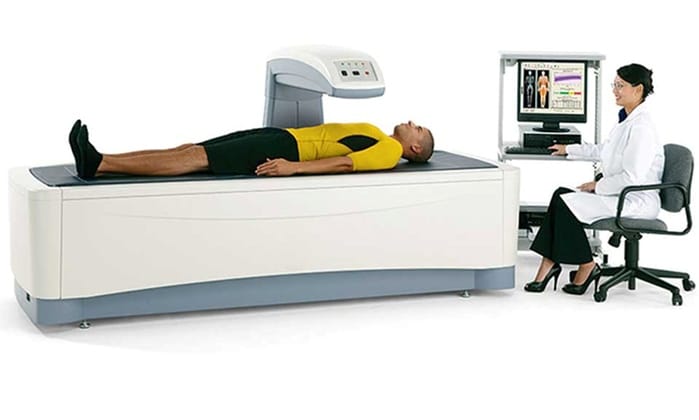
7. Air Displacement Plethysmography
This method is similar to underwater weighing but uses air instead of water. You sit in an egg-shaped chamber while the air pressure inside the chamber is changed to measure your body’s density. A swimsuit or tight clothing is needed to take accurate measurements during testing.
ADP is accurate and produces consistent readings. Unlike hydrostatic weighing, the chamber does not involve getting wet. ADP is suitable for people of all ages, sizes, and shapes, including children, the elderly, and those with disabilities.
The disadvantages of ADP include limited availability and a high cost. Some people may feel claustrophobic during the procedure. Furthermore, the test cannot precisely determine the location of body fat.
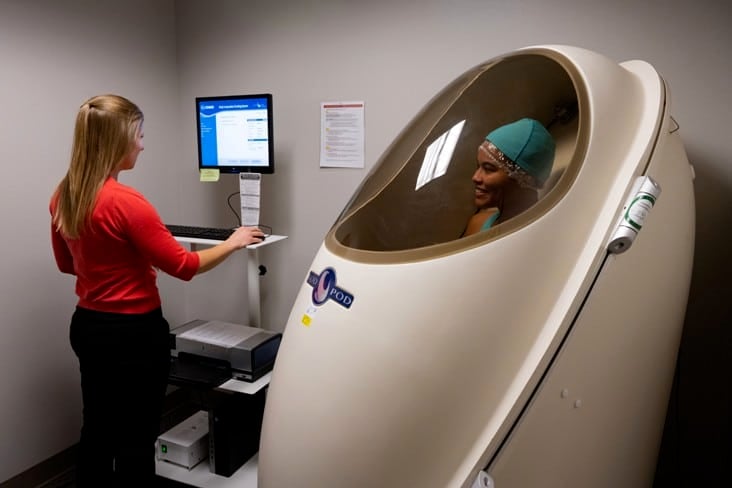
How To Use Body Fat Percentage Chart
Measuring body fat percentage is important for several reasons, including:
1. Assessing Overall Health
Measuring body fat percentage is more accurate than measuring body weight or BMI alone.
A high body fat percentage increases the risk of health problems such as heart disease, diabetes, and some cancers.
2. Tracking Weight Loss Progress
When trying to lose weight, tracking body fat percentage can provide a more accurate measure of progress than simply tracking weight.
It’s important to track body fat percentage to see if you’re losing mostly fat or muscle because weight loss can be due to fat and muscle mass loss.
Weight Loss Calculator-Know Your Calorie Requirement
3. Evaluating Fitness Level
Athletes and fitness enthusiasts often track body fat percentages to evaluate their fitness level and progress.
A lower body fat percentage can indicate a higher fitness level and better physical performance.
4. Personalizing Nutrition And Exercise Plans
Knowing your body fat percentage can help you personalize your nutrition and exercise plans to achieve your goals.
For example, if your body fat percentage is too high, you may need to adjust your diet and exercise routine to focus more on fat loss.
5. Setting Realistic Goals
Measuring body fat percentage can help you set realistic weight loss or muscle gain goals. It also allows you to monitor changes in your body composition over time.
For example:
- If your body fat percentage is currently 30%, you may set a goal to reduce it to 25%.
- If you’re trying to gain muscle mass, you can track your body fat percentage to ensure that you’re gaining mostly muscle and not just fat.
Weight Gain Calculator: Know Your Calorie Requirement to Build Muscle Mass
How To Reduce Body Fat
- Create a calorie deficit by consuming fewer calories than you burn through exercise and daily activities.
- Incorporate strength training exercises to build lean muscle mass, which can help increase your metabolism and burn more calories.
- Incorporate cardiovascular exercise into your routine, such as running, biking, or swimming, to burn additional calories and improve heart health.
- Eat a balanced and nutritious diet with plenty of fruits, vegetables, lean protein, and healthy fats.
- Reduce your intake of processed and high-fat foods.
- Stay hydrated by drinking plenty of water throughout the day.
- Get enough sleep to allow your body to recover and regulate hormones that affect metabolism and appetite.
- Reduce stress levels through practices such as meditation, yoga, or deep breathing exercises.
- Stay consistent and patient, as reducing body fat takes time and effort.
FAQs
How can I measure my body fat at home?
Several methods, such as bioelectrical impedance analysis (BIA) scales, skinfold calipers, and tape measurements, can be used to measure body fat at home.
However, It is important to note that these methods may not be as accurate as professional assessments and may have limitations or room for error.
What should women’s body fat percentage be?
A healthy range for women is generally considered to be between 20-32% body fat. As the women’s body fat percentage varies based on factors such as age, fitness level, and body composition goals there is no one-size-fits-all answer to what it should be.
How accurate is a body fat chart?
Body fat charts provide a general guideline for healthy body fat percentages, but they may not be 100% accurate for everyone.
Factors such as muscle mass, bone density, and hydration levels can all affect body fat readings.
What are the risks of having too much or too little body fat?
Having too much body fat can increase the risk of health issues such as heart disease, stroke, diabetes, and certain cancers.
On the other hand, having too little body fat can lead to a weakened immune system, decreased energy levels, and reproductive issues. Maintaining a healthy body fat percentage is important for overall health and well-being.
Takeaways
The body fat chart provides a general idea of a healthy body fat percentage range. Several methods are available to measure body fat percentage, ranging from simple and inexpensive to more accurate but expensive.
Getting an accurate body fat percentage reading at home is difficult, but using BMI calculations or fat calipers can provide an approximate estimate.
While body fat is an important health indicator, it has its limitations. Instead of solely focusing on body fat, prioritizing a healthy lifestyle through regular exercise, strength training, and a balanced diet is key to maintaining good health.
Reference
- https://www.acefitness.org/resources/everyone/tools-calculators/percent-body-fat-calculator/
- Body composition information and FAQ’s sheet [Fact sheet]. (n.d.).
http://pennshape.upenn.edu/files/pennshape/Body-Composition-Fact-Sheet.pdf - Your Body Fat Percentage: What Does it Mean?. Beth Israel Lahey Health Winchester Hospital. Accessed 10/30/21.
- Gallagher D, Heymsfield SB, Heo M, Jebb SA, Murgatroyd PR, Sakamoto Y. Healthy percentage body fat ranges: an approach for developing guidelines based on body mass index. Am J Clin Nutr. 2000; 72(3):694-701.
- ACSM’s Guidelines for Exercise Testing and Prescription. American College of Sports Medicine. Accessed 10/30/21.
- https://acewebcontent.azureedge.net/continuingeducation/courses/support_items/OLC-MATH-10/coursecontent.pdf

Manish brings over 10 years of hands-on experience in weight lifting and fat loss to fitness coaching. He specializes in gym-based training and has a lot of knowledge about exercise, lifting technique, biomechanics, and more.
Through “Fit Life Regime,” he generously shares the insights he’s gained over a decade in the field. His goal is to equip others with the knowledge to start their own fitness journey.
